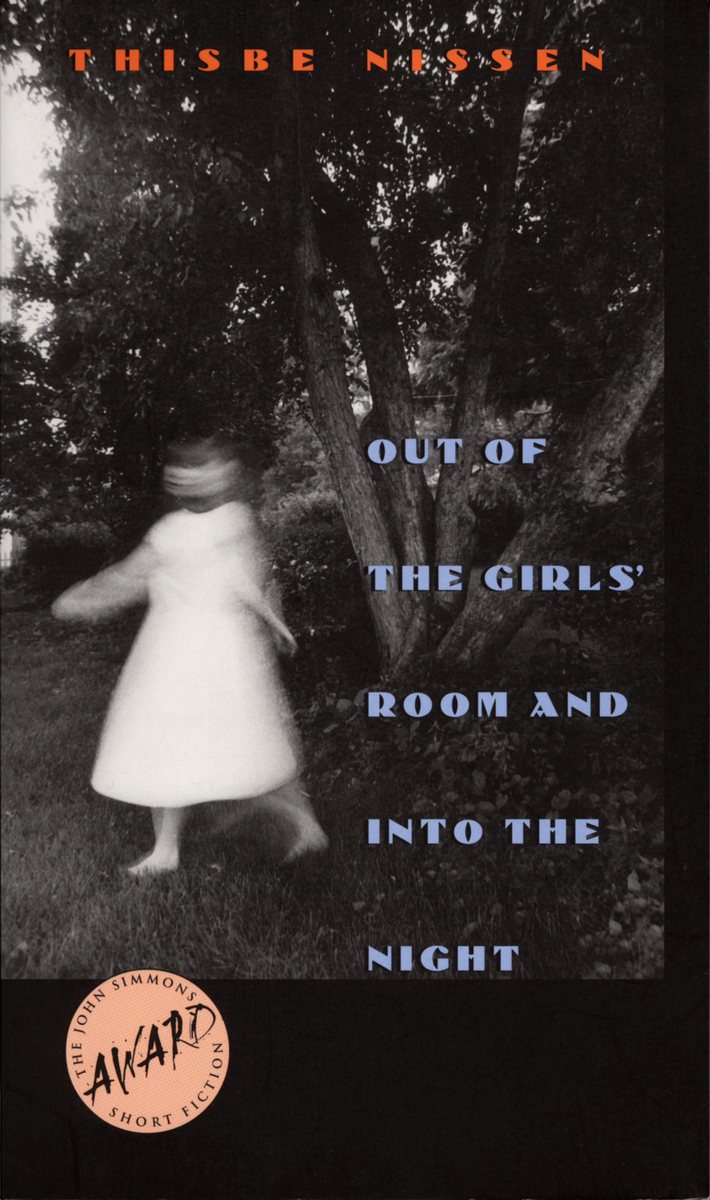Out of the Girls' Room and into the Night is a spirited, offbeat collection of stories, elongated riffs on that thing we call …love. All manner of love stories: thwarted love stories, imaginary love stories, love stories offhand and obsessive, philosophical love stories, erudite and amusing love stories.
“People don't meet because they both like Burmese food,” says one character, “or because someone's sister has a friend who's single and new in town, or because Billy's nose happened to crook just slightly to the left at an angle that made me want to weep…People don't fall in love with each other …they just fall into love.”
Everyone does it: women of fierce independence, men of thin character, rambling Deadheads, gay teenage girls, despondent Peace Corps volunteers, anorexic Broadway theatre dancers, the eager, the grieving, the uncommunicative. Even the confused do it. And they don't just fall in love with each other—they fall in love with certain moments and familiar places, with things as ephemeral as gestures and as evanescent as sunlight.
Quirky, real, idealistic, deluded, bohemian, and true, these are people who can—and often do—fall in love with a pair of ears, August afternoons, saucers of vitamins, New Age carpenters, and dead bumblebees. And if there's something they can teach us, it's how to conceive of alternative worlds and the terror and the exhilaration of venturing outside the confines of the lives we know and making our way into a dark, glittering unknown.
Several of the stories in Out of the Girls' Room and into the Nighthave been published previously. They are:
“A Brownstone, Park Slope,” The North American Review, May/August 1999
“A Bungalow, Koh Tao,” Fourteen Hills,. Spring/Summer 1999
“3 1/2 x 5,” Wisconsin Review, Spring 1999
“Mailing Incorrectly,” Reed Magazine, summer 1998
“Apple Pie,” Sycamore Review, Winter/Spring 1998
“Grog,” Spelunker Flophouse, summer 1997
“The Estate,”Hampton Shorts, summer 1997
“At the No. 1 Phoenix Garden,” Story, spring 1997
“Accidental Love,”Seventeen, December 1996
“Fundamentals of Communication,” available at Atlantic Monthly's online magazine
“These stories abound in a rich life, holding sad, awkward, edgy contemporaneity in their generous embrace. They do not soothe or forgive or reassure; they love the creature as it is. There is great originality and great freedom in Thisbe Nissen's approach to her subject, a kind of classicism in her lucid and compassionate interest in the ways of this present world.”—Marilynne Robinson
“Moving from the chaotic world of adolescence and into adulthood is the theme that links Nissen's bittersweet collection of 25 fierce and quirky short stories, the winner of the John Simmons Short Fiction Award. Familiar issues are dealt with innovatively—young women (and some men) deal with eating disorders, illness, death, infidelity and love. The cast is an eclectic crew of original, sometimes bizarre, yet recognizable characters with names like Silver Tarkington, Wing MacArdle, Moët and Zagarella. The settings range from Santa Cruz to the Midwest, Manhattan to Paris. With self-deprecating and wry humor, Nissen's characters frequently improvise unusual answers for difficult, confusing questions. In “Way Back When in the Now before Now,” Sari, a city-savvy teenager whose mother is dying of cancer, slips into the bed of her best friend's brother, searching for comfort in “The hot sleepy boy-smell with its acrid twinge of sex.” “The Estate” charts the fleeting passage of time as experienced by a close-knit group of friends and family summering together annually at a carriage house on a large property. Other stories feature young hippies hoping to make a Grateful Dead show; a group of eight women living in a feminist co-op; a child coping with being pushed too hard by ambitious, cold parents. In these tales, as in others, Nissen displays a sharp talent for fresh detail and dialogue: Barb-Jean, a soprano who conserves her voice for days at a time, communicates through scraps of paper. “When we cleaned the house…at the end of the season we'd find fragments of conversation stuck between the couch cushions and tucked into kitchen drawers: how many people? how many ears? Portuguese on her mother's side I think, Sot—5 letters—ends in a y.” Many of the stories in this warm, fearless collection trace college love affairs and exquisite, if tentative, sexual explorations between young women. Where a few tales are merely good, several of them are stellar, marking Nissen as an assured writer whose wide-ranging interest in varied people and life situations creates lively fiction.”—Publishers Weekly
“Absolutely stunning. Ms. Nissen's characters are among the most honest, difficult, endearing, expansive, and blatantly human that I have encountered on the page in quite some time.”—Jules Davis, Pendragon Books, Oakland CA, in The Book Sense 76
“…these smoothly polished little narrative gems are not about love at all so much as they are about the desire for what love signifies: placing yourself in context, finding comfort enough inside your own skin to turn your attention to the world and welcome it…With wry humor and uncommon poignancy, Thisbe distills entire emotional universes into her slim stories. You may never have lived with seven other women during a semester of nervous breakdowns and supernatural events, found yourself preferring your boyfriend's sister to your actual boyfriend, or lost a parent to a freak accident, but you'll recognize parts of yourself in Girls' Room.—Bitch: Feminist Response to Pop Culture
“…an awe-inspiring collection of short stories…Nissen's characters are young and yearning, and they come together in lovely and unexpected ways…Although [her] characters are generally young and blessed—traveling Deadheads, college housemates, wealthy New York teens—Nissen bestows them with earnesty and explores their desires carefully and with gravity.”—Austin Chronicle



